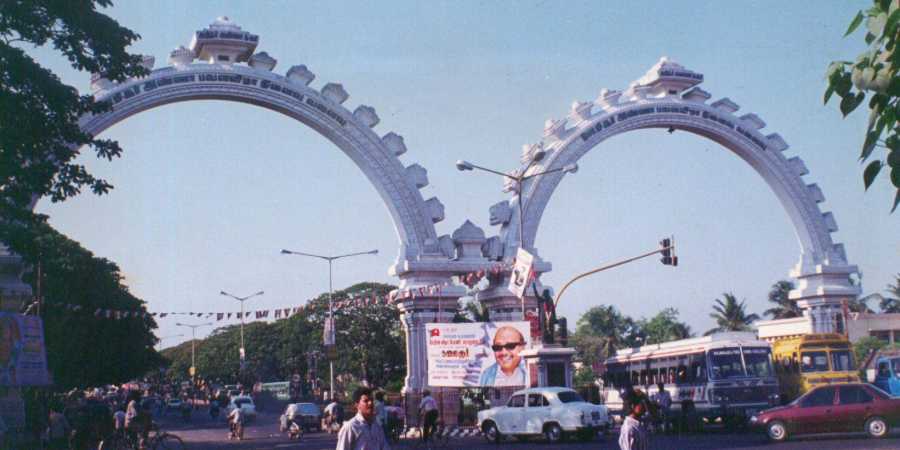From a village settlement to the commercial and residential hub it is today, locals trace the history of their neighbourhood.

Chennai :
A scene from the 1971 film Rickshawkaran featuring the late actor-former chief minister of Tamil Nadu MG Ramachandran racing in a wagon on the roads of Anna Nagar is one that’s etched in the minds of Tamil film enthusiasts.
A closer look at the background, and one can spot the 51-year-old Anna Tower, one of the popular landmarks of Namma Chennai. While not much has changed about the magnificent edifice, the locality where it stands has seen exponential changes since its origin.
Since 2013, Nam Veedu, Nam Oor, Nam Kadhai, a social history group headed by architect-planner Thirupurasundari has been recording the evolution of Anna Nagar. As part of the Madras Week celebrations, the group curated a two-day exhibition featuring panels of the history and heritage of the neighbourhood, at Joy of Books.
Community initiative
“A few years ago, when preparations for Madras Day were in full swing, I noticed that no heritage events were being conducted in this part of the city. That’s when I decided to form this group to simply understand the locality. But, I didn’t want to constrain myself to just hosting walks or talks,” said Thirupurasundari, a resident of Shenoy Nagar.
The initiative spread like wildfire — thanks to community tabloids and the locality’s heritage crusaders. “When we began, we had a simple concept — to explore and document the history and heritage of the neighbourhood I was from. Six years later, it has grown and become a community initiative. There’s a sense of ownership among the residents about the area now,” she said.
A rural flavour
Before the 1950s, the village of Naduvakkarai had a truly rural flavour, with paddy fields and a serene river flowing nearby. Impressed by the true rural essence in the otherwise busy city as seen in Mount Road and Parrys, a few people settled down here to appreciate its silence and serenity, writes Thirupurasundari in a booklet released by the group in 2014.
People from other busy pockets of the city, including Mylapore and Triplicane, began migrating to Naduvakkarai in the 1940s and 50s. An illustrated depiction of this event by Akshayaa Selvaraj was on display. “When we interviewed the residents, some senior citizens even told us that they moved here because palm jaggery and first-class toddy were available here. Naduvakkarai had an abundance of palm trees,” said the architect.
Post-freedom rush
In the early 1960s, due to mushrooming of industrial pockets and rapid migration in the city, the housing board was formed to provide necessary housing facilities. In the wake, the West Madras Neighbourhood Scheme, which initiated subsidised development schemes and other structures was born. “The blueprint of contemporary Chennai was beginning to emerge. The idea of an integrated system of housing, meant for all classes possibly for the first time in the country, was initiated,” she said.
Guided through
Since the roads in Anna Nagar are designed based on matrix structure or similar to roads in developed countries in the western world, for many, hunting for the right lane and street is a task. Thirupurasundari said that between 1968 and the early 80s, Anna Nagar had guides who used to help people navigate. “These guides used to charge `1 or `2 and would guide you to whatever place you wanted to go to in the locality,” she said.
A historic fair
The 1968 Indian International Trade and Industries Fair, aimed to show India’s industrial development, changed the face of the neighbourhood. Brands like Voltas to Ovaltine had put up stalls as part of the fair. One of the main attractions was the Panchsheel tower (now called the Anna Tower) from which a panoramic view of the fair-site could be seen for a rupee or less.
After the fair’s success, more people were drawn towards the locality. “Interestingly, my amma and appa had attended the fair too. He was five and she was three years old. They both remember sitting in the Russian pavilion. This was the time when paper cups were emerging, and they both remember refusing to drink from a cup made of paper!” she said.
Interactive tour
We took a tour of the exhibition — from touch and feel exhibits depicting layouts of the State Housing Board’s West Madras Neighbourhood Scheme, panels of the 1968 Indian International Trade and Industries Fair, the evolution of Chandramoulishwarar temple, vintage images of the parabolic archway, screengrabs of film scenes that featured Anna Nagar, and other representational panels were on display. A drawing competition, quiz, storytelling session about Madras, display of household heritage items by Venkatraman Prabakaran and Sivagamasundari T, and early residents sharing anecdotes about the area were also part of the event.
“Talking to people who witnessed the stages of the neighbourhood’s development was essential. We have so far done 672 interviews of residents, senior citizens…they’ve all been kind and generous. Most of what you see here is a collation of all the information they gave us. From old photographs, maps and layouts of the area, they came forward to share whatever they know about Anna Nagar,” she shared.
source: http://www.newindianexpress.com / The New Indian Express / Home> Cities> Chennai / by Roshne Balasubramanian / Express News Service / August 22nd, 2019